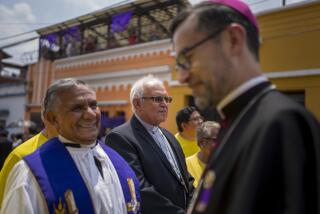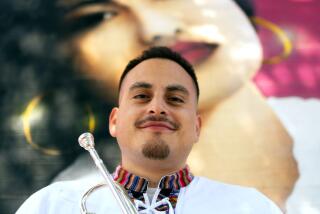Peruvian legend perseveres
el carmen, peru -- For visiting musicians and artists, a stop at the modest home of Amador Ballumbrosio, the godfather of Afro-Peruvian music, has long been a rite of passage.
But the massive earthquake that hit Peru on Aug. 15 opened up cracks in the walls and ceilings of the adobe dwelling on a residential street here, almost forcing the family to evacuate.
Despite the damage, the septuagenarian patriarch refuses to leave the comfortably cramped haven where he and his wife raised more than a dozen children, many of whom are musicians and dancers.
Ballumbrosio, confined to a wheelchair for several years, said he sensed the nearness of death as his house shook like a boat tossed about at sea.
“It felt like the end of the world,” recalls the storied folk violinist and past master of the tap dance known as the zapateo. “I prayed to the Almighty.”
The damage to Peru’s black heartland, which gained international notice with the 1990s world music breakthrough of the Afro-Peruvian sound, has been widespread.
A few blocks from Ballumbrosio’s adobe home stands the battered hulk of Our Lady of El Carmen Roman Catholic Church, a cultural landmark that suffered a toppled bell tower, cracked facade and extensive interior breakage.
It is one of many colonial-era churches badly damaged in the quake, which killed more than 500 people and left tens of thousands homeless. Also in ruins is a nearby national monument, the Hacienda San Jose, a former plantation house.
But repairing historic sites is a secondary task in quake-battered Peru.
“We must first attend to the desperate needs of our parishioners,” notes Father Lorenzo Bergantin, an Italian Comboni missionary who is the parish priest of rural El Carmen.
Left without inhabitable dwellings were perhaps half or more of the 10,000 residents of El Carmen, which bills itself as Peru’s “capital of folklore and black art.”
The township is widely known for its evocative music, gleeful festivals, talented soccer players and gracious inhabitants.
El Carmen and the broad coastal zone devastated by the quake boast a singular fusion of cultures: The bloodlines of African slaves, indigenous Andean peoples, European settlers and Chinese laborers are evident here. Intermarriage over time has produced a vivid variety of skin hues and hair textures.
“We’re all mixed,” says a former mayor, Elias Rebata, 56, one of a family of 21 children born in this agricultural community.
Many carmelitanos, as residents are known, left after the quake to join relatives in Lima, the relatively unscathed capital 120 miles to the north; others now sleep in encampments hastily put up in plazas and pitches of grass, a ubiquitous scene in the vast earthquake-ravaged zone.
Even houses that appear undamaged on the outside have deep interior fissures, and may be poised to collapse.
“People are making do as best they can,” says Juan Roberto Flores, 64, leading visitors through dirt streets featuring toppled adobe homes and lines of residents queuing for donated food.
He and his wife now sleep in a tent pitched in the palm-shaded central plaza.
If there is any consolation, it is that no one was killed in El Carmen. Many attribute the paucity of casualties to the town’s beloved patron and protector, the Virgin of El Carmen, whose image is hoisted about the town on the feast days of July 16 and Dec. 27. Children, who practice for weeks, dance the steps of the zapateo during the religious processions.
“The Virgin saved us from an even worse fate,” says Pilar Joya, a 31-year-old mother of four living in a tent. “She watches over us.”
Word of the destruction has spread to aficionados of the sound that burst onto the world music scene with the release of the 1995 compilation “Afro-Peruvian Classics: The Soul of Black Peru,” co-produced by David Byrne, the ex-Talking Heads frontman.
“The earthquake has been a tremendous blow for the Afro-Peruvian community,” says Susana Baca, a well-known black chanteuse from Lima who has toured the U.S. and Europe and is a dedicated preserver of the cultural legacy. “Friends have called me from Boston, Barcelona, Switzerland, Berlin. They all want to know: ‘What can we do?’ I tell them their help will be needed to rebuild.”
Reconstruction seems likely to take years.
Even amid the current hardships, carmelitanos harbor no doubts: Neither the shaking of the earth nor the vast destruction will smother the melancholy and joyful sounds of Afro-Peru.
--
patrick.mcdonnell @latimes.com
More to Read
Sign up for Essential California
The most important California stories and recommendations in your inbox every morning.
You may occasionally receive promotional content from the Los Angeles Times.










